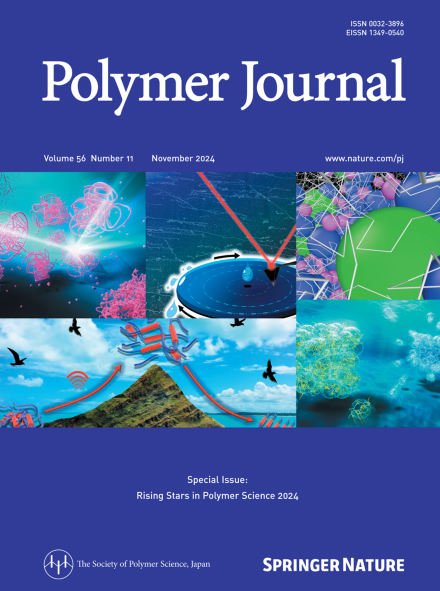Structures and properties of temperature-responsive gels with homogeneous networks prepared by photogelation of four-armed star-shaped poly(N-isopropylacrylamide)
IF 2.7
4区 化学
Q3 POLYMER SCIENCE
引用次数: 0
Abstract
The network structures of polymer gels strongly influence their mechanical properties and stimuli responsiveness. Recently, many scientists have attempted to prepare well-defined gels with homogeneous networks from four-armed star-shaped polymers such as four-armed poly(ethylene glycol) (Tetra-PEG). In this study, we synthesized a four-armed star-shaped block copolymer by the copolymerization of N-isopropylacrylamide (NIPAAm) and allylacrylamide (AllAm) via single-electron transfer living radical polymerization (SET-LRP) using a four-branched initiator. The resulting four-armed star-shaped copolymer (Tetra-PNIPAAm-b-PAllAm) was crosslinked with hexa(ethylene glycol) dithiol upon visible light exposure. The resulting gels (Tetra-PNIPAAm gels) exhibited slower temperature responsiveness than the general PNIPAAm gel prepared by the standard free radical copolymerization of NIPAAm and N,N’-methylenebisacrylamide. Dynamic light scattering (DLS) measurements revealed that the Tetra-PNIPAAm gels had more homogeneous networks than the general PNIPAAm gels. The slow temperature responsiveness of the Tetra-PNIPAAm gels is attributable to their more homogeneous network structure than that of the general PNIPAAm gels. Thus, four-armed star-shaped PNIPAAm is a useful building block for designing well-defined temperature-responsive gels with homogeneous networks. Well-defined temperature-responsive gels with homogeneous network structures were prepared by photogelation of a four-armed star block copolymer composed of N-isopropylacrylamide and allylacrylamide upon visible light exposure. The dynamic lightscattering measurements revealed that the resulting gels had homogeneous networks, influencing the kinetics of temperature-responsiveness.

四臂星形聚n -异丙基丙烯酰胺光凝胶的结构与性能
聚合物凝胶的网状结构对其力学性能和刺激响应性有很大影响。最近,许多科学家试图用四臂星形聚合物(如四臂聚乙二醇)(tetrao - peg)制备具有均匀网络的明确定义的凝胶。本研究采用单电子转移活性自由基聚合(SET-LRP),以四支引发剂为引发剂,将n -异丙基丙烯酰胺(NIPAAm)和烯丙烯酰胺(AllAm)共聚合成了一种四臂星形嵌段共聚物。得到的四臂星形共聚物(tetrai - pnipaam -b- pallam)在可见光照射下与六(乙二醇)二硫醇交联。所得凝胶(四聚PNIPAAm凝胶)的温度响应性比用NIPAAm和N,N ' -亚甲基双丙烯酰胺标准自由基共聚制备的普通PNIPAAm凝胶要慢。动态光散射(DLS)测量结果表明,四聚PNIPAAm凝胶比普通PNIPAAm凝胶具有更均匀的网络。与普通PNIPAAm凝胶相比,四聚PNIPAAm凝胶的网络结构更为均匀,其温度响应速度较慢。因此,四臂星形PNIPAAm是设计具有均匀网络的明确温度响应凝胶的有用构建块。用n -异丙基丙烯酰胺和烯丙烯酰胺组成的四臂星形嵌段共聚物在可见光下光凝胶化制备了具有均匀网络结构的温度响应凝胶。动态光散射测量表明,所得凝胶具有均匀的网络,影响了温度响应动力学。
本文章由计算机程序翻译,如有差异,请以英文原文为准。
求助全文
约1分钟内获得全文
求助全文
来源期刊

Polymer Journal
化学-高分子科学
CiteScore
5.60
自引率
7.10%
发文量
131
审稿时长
2.5 months
期刊介绍:
Polymer Journal promotes research from all aspects of polymer science from anywhere in the world and aims to provide an integrated platform for scientific communication that assists the advancement of polymer science and related fields. The journal publishes Original Articles, Notes, Short Communications and Reviews.
Subject areas and topics of particular interest within the journal''s scope include, but are not limited to, those listed below:
Polymer synthesis and reactions
Polymer structures
Physical properties of polymers
Polymer surface and interfaces
Functional polymers
Supramolecular polymers
Self-assembled materials
Biopolymers and bio-related polymer materials
Polymer engineering.
 求助内容:
求助内容: 应助结果提醒方式:
应助结果提醒方式:


